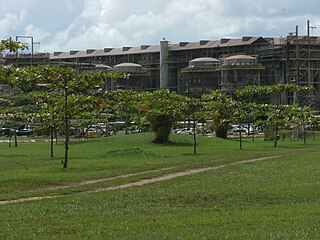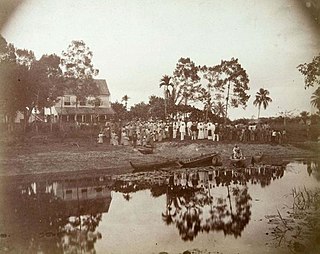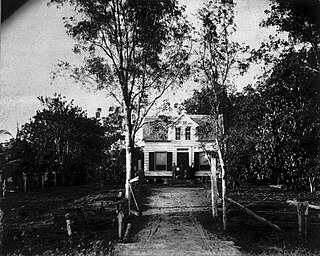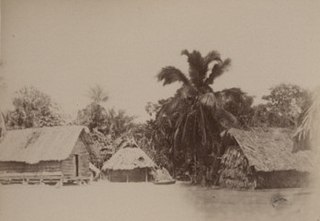
Paramaribo is a district of Suriname, encompassing the capital city of Paramaribo and the surrounding area.

Johan & Margaretha or sometimes just Margaretha is a resort in Suriname, located in the Commewijne District. Its population at the 2012 census was 756. It is located along a peninsula northeast of Paramaribo. It is named after the coffee plantation Johan & Margaretha which was founded in 1745 by Johan Knöffel. It is safe to assume that his wife was called Margaretha.

Noord is a resort in Suriname, located in the Para District. Its population at the 2012 census was 9,703. Noord is mainly an agricultural area, and has a school.

Oost is a resort in Suriname, located in the Para District. Its population at the 2012 census was 8,016. The main town in the resort is Paranam. Oost is also home to the former leper colony Bethesda. The Paranam alumina refinery is located near the town of Paranam. The Accaribo area is becoming tourist spot with the main attractions White Beach and Caribo Beach Resort.

Zuid is a resort in Suriname, located in the Para District. Its population at the 2012 census was 6,113. The main ethnic groups are indigenous, Creoles, and mixed race.

Flora is a resort in Suriname, located in the Paramaribo District. Its population at the 2012 census was 19,538. Flora is both the name of the resort and the neighbourhood within the resort. Flora was founded as a wood plantation in 1809.

Latour is a resort in Suriname, located in the Paramaribo District. Its population at the 2012 census was 29,526. Latour is a low income neighbourhood with large unemployment. Latour is the most populous resort of Paramaribo.

Livorno is a resort in Suriname, located in the Paramaribo District. Its population at the 2012 census was 8,209.

Tammenga is a resort in Suriname, located in the Paramaribo District. Its population at the 2012 census was 15,819. The resort has been named after Henderijkes Tammenga (1815-1864), who after his first plantation did not succeed, started farming in a swampy area near Paramaribo in 1852. Most of the area was sold to East Indian indentured workers in the late 19th century.

Welgelegen is a resort in Suriname, located in the Paramaribo District. Its population at the 2012 census was 19,304.

Boven Saramacca is a resort in Suriname, located in the Sipaliwini District. Its population at the 2012 census was 1,427. The dominant geographical feature of this resort is the Saramacca River. The resort is mainly inhabited by Maroons of the Matawai tribe.

Calcutta is a resort in Suriname, located in the Saramacca District. Its population at the 2012 census was 1,647, and is mainly inhabited by East Indians. The town is named after Calcutta, India. From 1873 onwards, indentured workers were recruited from India to work the plantations. Most of the workers departed from Calcutta. About one third returned to India, but most decided to stay in Suriname.

Kampong Baroe is a resort in Suriname, located in the Saramacca District. Its population at the 2012 census was 2,248, the majority being Javanese, and East Indian. The main agricultural crop is peanuts. Kampong Baroe also contains cattle, pig, and chicken farms. "Kampong Baroe" in Malay language literally means "New Village".

Tijgerkreek is a resort in Suriname, located in the Saramacca District. Its population at the 2012 census was 3,244, the majority being Javanese, and East Indian. The resort is mainly agricultural. In the 21st century, there has been an emphasis on peanuts. The development of a modern agricultural centre is being planned.

Wayamboweg is a resort in Suriname, located in the Saramacca District. Its population at the 2012 census was 1,560. The largest ethnic group is East Indian. The resort is mainly agricultural. A rice project has started in late 2017.

De Nieuwe Grond is a resort in Suriname, located in the Wanica District. Its population at the 2012 census was 26,161. Its main ethnic groups are East Indian, and Creoles. The resort is named after a sugar plantation in 1770. The plantation was already abandoned in 1863, when slavery was abolished, because that year, it was up for public auction. The area used to consist of small scale agriculture with a focus on vegetables and rice, but due to its proximity to Paramaribo, it has become a suburban area with a young population. In 2019, a new bigger market opened in the town.

Houttuin is a resort in Suriname, located in the Wanica District. Its population at the 2012 census was 15,656. The largest ethnic group are the Indo-Surinamese. The resort is named after the sugar plantation Houttuyn which was founded in 1737. The resort was mainly agricultural, and is planned to remain an agricultural centre. In the early 21st century, it has seen a steady population growth, and is becoming suburban with housing projects like Tout Lui Faut.

Koewarasan is a resort in Suriname, located in the Wanica District. Its population at the 2012 census was 27,713. It is located to the west of Paramaribo, and is mainly a suburban area. The municipality was founded in 1939, and was originally intended for the Javanese settlers from Java, however due to World War II, only a single group arrived. The majority of the population are East Indian. Prior to 1939, Koewarasan was an agricultural area used for the cultivation of rice.

Kwatta is a resort in Suriname, located in the Wanica District. Its population at the 2012 census was 14,151.

Saramacca Polder is a resort in Suriname, located in the Wanica District. Its population at the 2012 census was 10,217. And the majority of the population is of East Indian descent. The Saramacca Polder was created between 1894 and 1904. The main function was agriculture. The Commissaris Weytinghweg was built in 1906, and connects the polder with Paramaribo. Initially the area was mainly used for rice cultivation, but has become home to companies and suburban housing.















